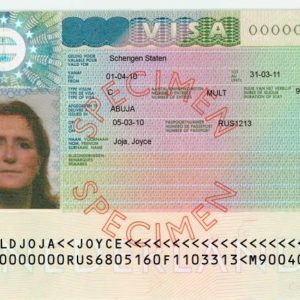The Schengen visa is a short stay visa that gives access to the bearer to freely circulate in 26 European states to the bearer. All these states have abolished internal border controls enabling free movement within one single common travel area.
A Schengen visa is an authorisation issued by a Schengen State to transit through or an intended stay in the territory of the Schengen States of a duration of no more than 90 days in any 180 days period (“short stay visa”)
What is Schengen Area?
The Schengen area was created in 1985 after an agreement signed by between 5 states on 14 Jun 1985 to abolish internal border controls. It was later hailed as remarkable achievement towards free movement of people. These five countries are
1. Belgium
2. France
3. West Germany
4. Luxembourg
5. Netherlands
The name Schengen is the name of small town in Luxembourg where the agreement was signed. Today the schengen area expanded quickly to 26 states, comprising of 420 million people, 4.3 million square km and $15 trillion market.
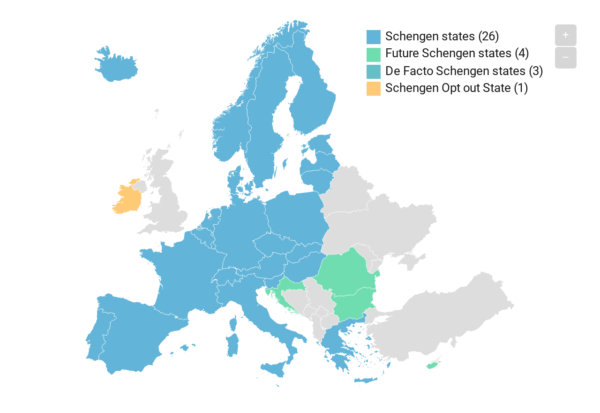
Schengen Members
There are total 26 states that form schengen area.
EU-member states:
22 EU countries that are part of the Schengen area borders
Austria, Belgium, Czechia, Denmark, Estonia, Finland, France, Germany, Greece, Hungary, Italy, Latvia, Lithuania, Luxembourg, Malta, the Netherlands, Poland, Portugal, Slovakia, Slovenia, Spain and Sweden
Non-EU member states
These four EFTA Associated countries also participate in the schengen area:
Iceland, Liechtenstein, Norway and Switzerland
Non Schengen members
- EU member states: 4 EU members that are not part of the Schengen Area —Bulgaria, Croatia, Cyprus, and Romania—but are legally obliged to join the area in the future
- Defacto Microstates: Monaco, San Marino, and Vatican City
- Opt-out State – Ireland opted out therefore not part of Schengen area
- Territories – Territories of French, Dutch and British not part of schengen area
Note: Schengen states should not be confused with European Union member states.
Types of Schengen Visas
- A – Airport transit visa
- B – Transit visa valid for 5 days
- C – Uniform short stay less than 90 days (tourist, business, study)
- D – Long stay visas for more than 90 days (for residence permits)
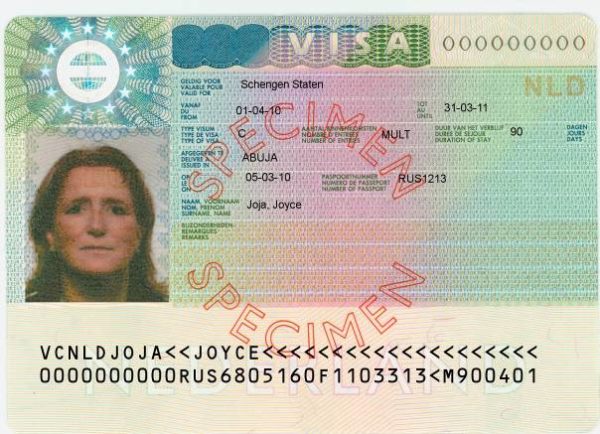
Visa fee: 80 euro (from Feb 2020)
Schengen Visas may be issued with limited territorial validity (eg. person holding a travel document not recognised by all Member States)
New Schengen Visa Changes in 2020
New EU schengen visa rules on short-stay visas came into effect from 2 February 2020 which will affect nationals of 105 countries who require a visa to enter schengen area.
- Visa fee: Visa application fee increased to €80 euros (from 60 euro). visa fee is still waived for children below 6 years old and minors age of 6 and 12 years are required to pay €40 euros
- Early applications: Visa applications can be submitted up to 6 months before the intended travel (9 months for seafarers), instead of 3 months previously, allowing travelers to better plan their trips;
- Multiple-entry visas with long validity (from 1 to 5 years) are now easier to obtain, saving frequent travellers time and money, as they will have to apply for a new visa less often. Frequent travellers with a positive visa history are to be granted multiple-entry visa with a gradually increasing validity period from 1 year to a maximum of 5 years.
- Electronic applications: In most cases, an application can be submitted directly in the traveller’s country of residence, and where possible filled in and signed electronically (only hard copies were accepted until now), which will also save travellers time, money and hassle.
- Processing times: 15 days remains unchanged and some applications take more time.
- Health insurance coverage: Present a medical travel insurance (must) covering the period of stay. Applicants must present a travel medical insurance covering emergency medical, hospitalisation and repatriation (including in case of death). The minimum cover should be of 30,000 EUR. This insurance must be valid for the entire Schengen area and throughout the duration of the stay.
Where to apply?
You must file an application for a Schengen visa at the Consulate of the country that you intend to visit, or – if you intend to visit more than one Schengen State, the Consulate of the country where you will spend the longest period.
As a general rule, you must apply for a visa at the Consulate with territorial competence for the country in which you legally reside.
Refusals
The decision to refuse a Schengen visa and the reasons for the refusal are notified to the applicant using a standard form. The decision will explain procedure and deadline for submitting an appeal.
What are the reasons for schengen visa refusal?
As a general rule, a uniform visa shall be refused when the examination of the application leads to one or more of the below conclusions:
1. the applicant has presented a travel document which is false, counterfeit or forged;
2. justification for the purpose and conditions of the intended stay was not provided;
3. the applicant did not provide proof of sufficient means of subsistence, both for the duration of the intended stay and for the return to his country of origin or residence, or for the transit to a third country into which he is certain to be admitted;
4. the applicant does not provide proof that he is in a position to lawfully acquire sufficient means of subsistence, for the duration of the intended stay and for the return to his country of origin or residence, or for the transit to a third country into which he is certain to be admitted;
5. the applicant has already stayed for 90 days during the current 180-day period on the territory of the Member States on the basis of a uniform visa or a visa with limited territorial validity;
6. the applicant is a person for whom an alert has been issued in the SIS for the purpose of refusing entry; in this case the Member State concerned shall be added;
7. the applicant is considered to be a threat to public policy or internal security by on or more Member States;
8. the applicant is considered to be a threat to public health of one or more Member States;
9. the applicant is considered to be a threat to the international relations of one or more the Member States;
10. the information submitted regarding the justification for the purpose and conditions of the intended stay was not reliable;
11. there are reasonable doubts as to the reliability as regards ….. (to be specified);
12. there are reasonable doubts as to the reliability or as to the authenticity of the supporting documents submitted or as to the veracity of their contents;
13. there are reasonable doubts as to the applicant’s intention to leave the territory of the Member States before the expiry of the visa;
14. sufficient proof that the applicant has not been in a position to apply for a visa in advance, justifying the application for a visa at the border, is not provided;
15. the applicant does not provide justification for the purpose and conditions of the intended airport transit;
16. does not provide proof of holding adequate and valid travel medical insurance, where applicable.
Duration of Stay
The days should be counted from the date you enter the Schengen area (the entry stamp) to the date you exit the Schengen area (the exit stamp), i.e. both days included.
As from 18 October 2013 for the vast majority of the third-country nationals – irrespective of being visa required or exempt – who intend to travel to the Schengen area for a short stay (contrary to reside in one of the Member States for longer than 3 months) the maximum duration of authorised stay is defined as “90 days in any 180-day period
The date of entry shall be considered as the first day of stay on the territory of the Member States and the date of exit shall be considered as the last day of stay on the territory of the Member States. Periods of stay authorised under a residence permit or a long-stay visa shall not be taken into account in the calculation of the duration of stay on the territory of the Member States.
Stays in Bulgaria, Croatia, Ireland, Romania, Cyprus and the United Kingdom shall not be taken into account as they are not (yet) part of the Schengen area without internal borders.
How Consulates assess schengen visa applications for risk?
Consulates shall assess: – the risk of illegal immigration by the applicant to the territory of Member States (i.e. the applicant using travel purposes such as tourism, business, study or family visits as a pretext for permanent illegal settlement in the territory of the Member States) and – whether the applicant intends to leave the territory of the Member States before the expiry of the visa applied for.
As a part of local Schengen cooperation, consulates should define ‘profiles’ of applicants presenting a specific risk, according to local conditions and circumstances which also takes account of the general situation in the country of residence (e.g. politically unstable areas, high level of unemployment and wide-spread poverty). ‘Profiles’ could be based on the stability of the applicant’s socio-economic situation, but each individual application shall be assessed on its own merits irrespective of possible ‘profiles’ having been drawn up. The use of local warning lists containing data on specific persons should be verified with national data protection authorities.
The individual level of stability depends on a number of factors:
– family links or other personal ties in the country of residence;
– family links or other personal ties in the Member States;
– marital status; – employment situation (salary level, if employed);
– regularity of income (employment, self-employment, pension, revenue from investment, etc.) of the applicant or of his/her spouse, children or dependants;
– the level of income; – the social status in the country of residence (e.g. elected to public office, NGO representative; profession with a high social status: lawyer, medical doctor, university professor);
– the possession of a house/real estate.
Other aspects to be verified:
– previous illegal stays in the Member States;
– previous abuse of social welfare in the Member States;
– a succession of different visa applications (for short stay or long stay visas) presented for different unrelated purposes;
– credibility of the inviting person when the invitation letter is presented.
Airport Visa
The Airport visa allows transit through the international transit areas of airports of the Schengen States
List of third countries whose nationals are required to be in possession of an airport transit visa when passing through the international transit area of airports situated on the territory of one/some Member States
You can be exempt from the airport transit visa requirement, if you:
- hold a valid visa or residence permit issued by a Schengen state;
- hold a visa valid for a Member State of the European Union or the European Economic Area, Canada, Japan or the United States ;
- hold a valid residence permit issued by a Member State of the European Union or the European Economic Area ;
- hold a residence permit issued by the Principality of Andorra, Canada, Japan, Republic of San Marino, or the United States, that guarantees unrestricted right of return;
- are a family member of a citizen of the EU, EEA or Switzerland ;
- hold a diplomatic passport;
- are a flight crew member national of a contracting party to the Chicago Convention on International Civil Aviation.
How to read Schengen Visa sticker?
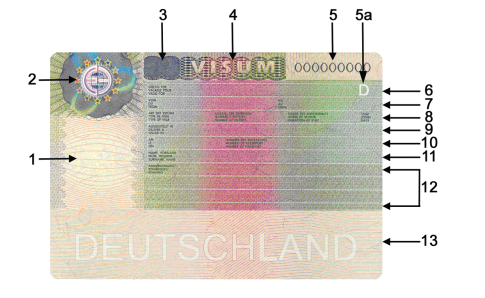
1. An integrated photograph produced to high security standards.
2. An optically variable mark (‘kinegram’ or equivalent) shall appear in this space. Depending on the angle of view, 12 stars, the letter ‘E’ and a globe become visible in various sizes and colors.
3. The logo consisting of a letter or letters indicating the issuing Member State (or ‘BNL’ in the case of the Benelux countries, namely Belgium, Luxembourg and the Netherlands) with a latent image effect shall appear in this space. This logo shall appear light when held flat and dark when turned by 90°.
The following logos shall be used:
A for Austria,
BG for Bulgaria,
BNL for Benelux ( Belgium, Netherlands and Luxembourg)
CY for Cyprus,
CZE for the Czech Republic,
D for Germany,
DK for Denmark,
E for Spain,
EST for Estonia,
F for France,
FIN for Finland,
GR for Greece,
H for Hungary,
HR for Croatia,
I for Italy,
IRL for Ireland,
LT for Lithuania,
M for Malta,
P for Portugal,
PL for Poland,
ROU for Romania,
S for Sweden,
SK for Slovakia,
SVN for Slovenia,
UK for the United Kingdom.
4. The word ‘visa’ in capital letters shall appear in the middle of this space in optically variable coloring. Depending on the angle of view, it shall appear green or red.
5. This box shall contain the 9-digit national number of the visa sticker, which shall be pre-printed. A special type shall be used.
5a. This box shall contain the three-letter country code as set out in ICAO Document 9303 on machine-readable travel documents (1), indicating the issuing Member State. The ‘number of the visa sticker’ is the three-letter country code as set out in box 5a and the national number as referred to in box
Exception for Germany: ICAO document 9303 on machine-readable travel documents provides for Germany the country code ‘D’.
6. This box shall begin with the words ‘valid for’. The issuing authority shall indicate the territory or territories for which the visa is valid.
7. This box shall begin with the word ‘from’ and the word ‘until’ shall appear further along the line. The issuing authority shall indicate here the period of validity of the visa. You must leave no later than the date printed in the “UNTIL” field.”
8. This box shall begin with the words ‘type of visa’. The issuing authority shall indicate the category of visa in conformity with Articles 5 and 7 of this Regulation. Further along the line the words ‘number of entries’, ‘duration of stay’ (i.e. duration of applicant’s intended stay) and again ‘days’ shall appear.
9. This box shall begin with the words ‘issued in’ and shall be used to indicate the place of issue.
10. This box shall begin with the word ‘on’ (after which the date of issue shall be filled in by the issuing authority) and further along the line the words ‘number of passport’ shall appear (after which the holder’s passport number shall appear).
11. This box shall begin with the words ‘Surname, Name’.
12. This box shall begin with the word ‘remarks’. It shall be used by the issuing authority to indicate any further information which is considered necessary, provided that it complies with Article 4 of this Regulation. The following two and a half lines shall be left empty for such remarks.
The full list of data entered in the comments sections is available here
13. This box shall contain the relevant machine-readable information to facilitate external border controls. The machine-readable area shall contain a printed text in the background printing, indicating the Member State issuing the document. This text shall not affect the technical features of the machine-readable area or its ability to be read. The paper shall have a natural colouring with red and blue markings. The words designating the boxes shall appear in English and French. The issuing State may add a third official Community language. However, the word ‘visa’ in the top line may appear in any one official language of the Community
Annulment of Visa
A visa shall be annulled where it becomes evident that the conditions for issuing it were not met at the time when it was issued, in particular if there are serious grounds for believing that the visa was fraudulently obtained. A visa shall in principle be annulled by the competent authorities of the Member State which issued it. A visa may be annulled by the competent authorities of another Member State, in which case the authorities of the Member State that issued the visa shall be informed of such annulment
Failure of the visa holder to produce one or more of the supporting documents referred to in point 5.2.1 or failure to prove, when presenting himself at the border, the possession of sufficient means of subsistence shall not automatically lead to a decision to annul the visa, especially if the visa has been issued by another Member State, but entry should be refused.
If the visa holder cannot prove the purpose of his/her journey when checked at the border, a further enquiry must be made in order to assess whether the person obtained the visa in a fraudulent way and represents a risk in terms of illegal immigration. If necessary, contacts with the competent authorities of the Member State having issued the visa will be taken. Only if it is ascertained that the visa was obtained in a fraudulent way, such visa must be annulled.
If a visa is annulled, a stamp stating “ANNULLED” shall be affixed to it and the relevant data shall be entered into the VIS.
Revoked Visas
A visa shall be revoked where it becomes evident that the conditions for issuing it are no longer met.
A visa is revoked at the border if the holder of the visa has become the subject of an alert in the Schengen Information System (SIS), since the visa was issued. A visa may be revoked at the request of the visa holder. Such a request should be made in writing.
Circumstantial evidence such as cancelled hotel or airline reservations, on its own, is not sufficiently reliable evidence to revoke the visa. In such cases, consulates should consider contacting the visa holder for an explanation of the change in travel plans before deciding whether a revocation is warranted
Persons whose visa has been annulled shall have the right to appeal. Appeals shall be conducted against the Member State that has taken the decision on annulment.
If a visa is revoked, a stamp stating “REVOKED” shall be affixed
When a visa has been revoked, the relevant data shall be entered into the VIS.
Border Controls
A Schengen state is permitted to reinstate border controls with another Schengen country for a short period where there is a serious threat to that state’s “public policy or internal security” or when the “control of an external border is no longer ensured due to exceptional circumstances”. When such risks arise out of foreseeable events, the state in question must notify the European Commission in advance and consult with other Schengen states.
These states have temporarily introduced border controls and the list is frequently updated here
- Norway (12 November 2019 – 12 May 2020)
Terrorist threats, secondary movements; ports with ferry connections with Denmark, Germany and Sweden; - Sweden (12 November 2019 – 12 May 2020)
Terrorist threats, shortcomings at the external borders; to be determined but may concern all internal borders; - Denmark (12 November 2019 – 12 May 2020)
Terrorist threats, organized criminality from Sweden; land border with Germany and with Sweden, ferry connections to Germany and to Sweden; - Germany (12 November 2019 – 12 May 2020)
Secondary movements, situation at the external borders; land border with Austria; - Austria (12 November 2019 – 12 May 2020)
Secondary movements, risk related to terrorists and organized crime, situation at the external borders; land borders with Hungary and with Slovenia; - France (31 October 2019 – 30 April 2020)
Persistent terrorist threat, upcoming high profile political event in Paris, secondary movements; all internal borders.
Important: Please note passport checks may be conducted at border in trains, bus, ship, car or at airports within schengen internal borders. You have to keep your passport with visas ready for police.
EU Security Databases
The EU uses large scale IT information sharing databases to protect its borders through effective law enforcement.
- Schengen Information System (SIS) – Centralised database for controls at external Schengen borders and law enforcement and judicial cooperation. SIS is a centralised, large-scale information system which stores alerts and provides information on wanted persons or objects. SIS will contain palm prints, fingerprints, facial images and DNA concerning missing persons. Bulgaria, Romania, Croatia and United Kingdom are connected to the SIS, while Ireland and Cyprus are not yet connected to SIS.
- Visa Information System (VIS) – VIS includes information on short-stay visas but also on long-stay visas and residence permits, as these documents allow for free movement within the Schengen area. Exchange of information on EU visas between Schengen Members. VIS connects consulates in non-EU countries and all external border crossing points of Schengen States. It processes data and decisions relating to applications for short-stay visas to visit, or to transit through, the Schengen Area. The system can perform biometric matching, primarily of fingerprints, for identification and verification purposes. As per the procedure, 10 fingerprints and a digital photograph are collected from persons applying for a visa. Data is kept in the VIS for five years.
- EURODAC – EU asylum biometric fingerprint database
- Entry / Exit System (EES) – System recording crossings of the external EU borders
- European Travel Information and Authorisation System (ETIAS) – Pre-travel security and irregular migration screening of visa-exempt non-EU nationals launching in 2021 for visa waiver countries.
The visa holder’s biometric identifiers will not be stored in the visa sticker itself, but in Visa Information System database.
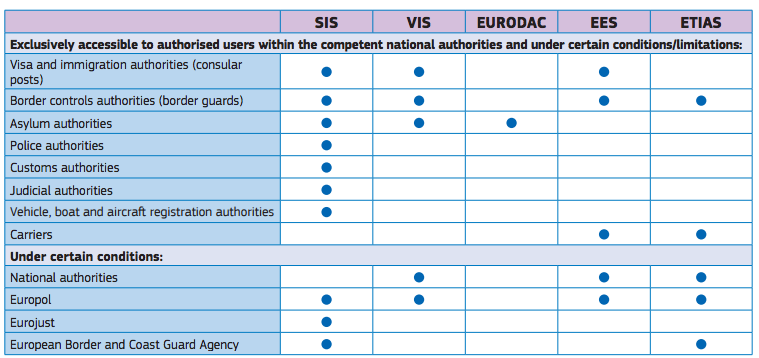
Schengen Survey
What do Europeans think of Schengen area?
A public survey was carried out in the 28 EU Member States between 23 June and 6 July 2018. Nearly 30,000 EU citizens from different social and demographic categories were interviewed face to face at home in their native language to get their views on the Schengen area.
Results
- Two thirds of Europeans have heard of the Schengen Area
- More than four in five are aware that their country belongs to Schengen zone
- Three-quarters of respondents agree that the Schengen Area is good for business in their country and nearly seven in ten agree it is one of the EU’s main achievements
- 75% of respondents indicated there is also a strong consensus that the Schengen Area is good for business in EU countries
- 80% of the respondents showed a clear support for more EU involvement in helping countries secure EU external borders
- Two thirds of those with experience of temporarily reintroduced internal border controls say that crossing took longer than before
- A quarter of respondents have had experience of reintroduced internal border controls
- 86% of respondents said holidays are the main reason for traveling to countries inside the Schengen Area
The questions were asked on:
- General awareness of the Schengen area;
- Travel patterns inside and outside the Schengen area;
- Perceptions of the Schengen area;
- Awareness of and experience with temporary reintroduced internal border control;
- Awareness of and support for EU external border control initiatives.

